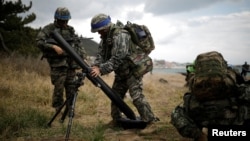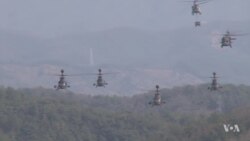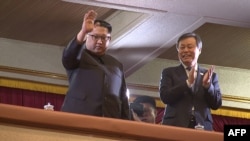Permanently ending the U.S.-South Korea joint military exercises that began this week could become a key factor in the nuclear talks with North Korea to come.
The annual combined military drills had been delayed to keep the peace during the Olympics in the South and reduced in scope to facilitate talks to end the North’s nuclear program.
WATCH: Brian Padden's video report
This year’s Foal Eagle and Key Resolve exercises will be similar to those in the past, with over 23,000 U.S. troops and 300,000 South Korean forces involved in both battlefield maneuvers, and responding to computer-simulated attacks from North Korea.
However this year, the defensive nature of the exercises are being emphasized, rather than offensive operations to target the leadership in Pyongyang that were practiced in the past. U.S. nuclear capable bombers and aircraft carriers are also not expected to participate this time around. And the training period has been shortened.
"The period has actually been reduced into half. Although it was announced that it is at the same level as in normal years, we see that it is reduced in size compared to other years," said Kim Tae-woo, a military analyst with Konyang University, and formerly with the South’s Korea Institute of Defense Analyses.
K-pop diplomacy
On Monday, the Seoul government barely acknowledged commencement of the military exercises. The Unification Ministry focused instead on the continued improvement of inter-Korean relations that was highlighted by South Korean K-pop singers preforming in Pyongyang on Sunday. North Korean leader Kim Jong Un’s attendance at the concert was seen as a reciprocal gesture of goodwill after South Korean President Moon Jae-in attended a North Korean orchestra in Seoul that was part of the North’s PyeongChang Olympics delegation.
"The fact that the leaders of both Koreas watched the North and South Korea’s art troupe performance is leading to a good atmosphere like a spring breeze for the successful hosting of the inter-Korean summit," said Baik Tae-hyun, the spokesman for the Ministry of Unification .
The two Koreas last week agreed to hold the Kim/Moon summit on April 27.
Bargaining chip
The downscaling of the exercises seems to be a temporary concession to maintain diplomatic momentum with North Korea that recently shifted away from conducting threatening missile and nuclear tests, to instead engage in upcoming denuclearization talks with South Korea and the U.S.
However there are concerns that further restricting and phasing out the joint drills could become a key focus of the nuclear negotiations.
"In order to make progress in the denuclearization front, South Korea will somehow have to downscale or even cancel the joint military exercise going down the road," said Go Myong-Hyun, a North Korea analyst with the Asan Institute For Policy Studies in Seoul.
The North Korean leader dropped his objection to the joint exercises that Pyongyang in the past called rehearsals for invasion, when he met recently with South Korean diplomatic envoy Chung Eui-yong.
However Kim also said ending the military threat against the North, a demand that in the past meant ending the U.S. military presence in Korea, would be a key condition for its nuclear disarmament.
"North Korea made a clear point of view for denuclearization on the Korean Peninsula and said that there was no need to keep its nuclear program as long as there was no military threat against it, and the safety of its regime was secured," said Chung, who is President Moon’s National Security Adviser.
Maximum pressure
The South Korean president has so far tried to balance outreach to the North with maintaining his country’s military alliance with the U.S. However, his perceived willingness to downgrade national security measures to advance his diplomatic agenda runs the risk of undermining the U.S. "maximum pressure" campaign.
"Seen from the perspective of the U.S., our ally, it can be a measure to lower the trust of the alliance," said Professor Kim.
For now, U.S. President Donald Trump, who has promised to maintain sanctions against the North and remain ready to use military force if needed, has shown flexibility both in agreeing to meet with Kim, and in going along with Moon’s request to downscale the joint exercises, to give diplomacy a chance.
Lee Yoon-jee in Seoul contributed to this report.
















